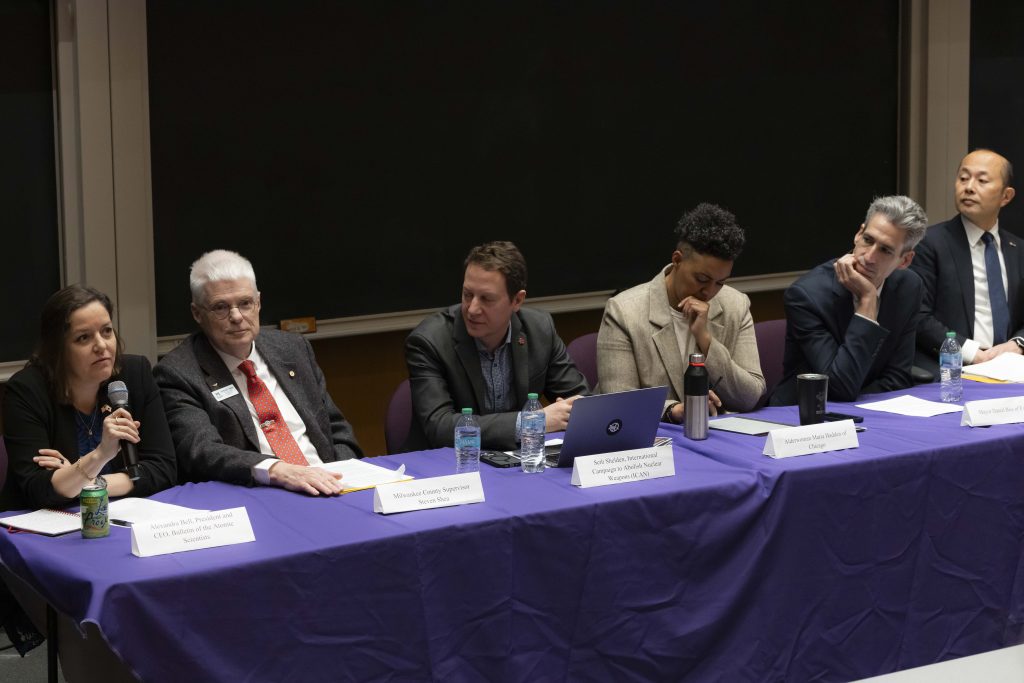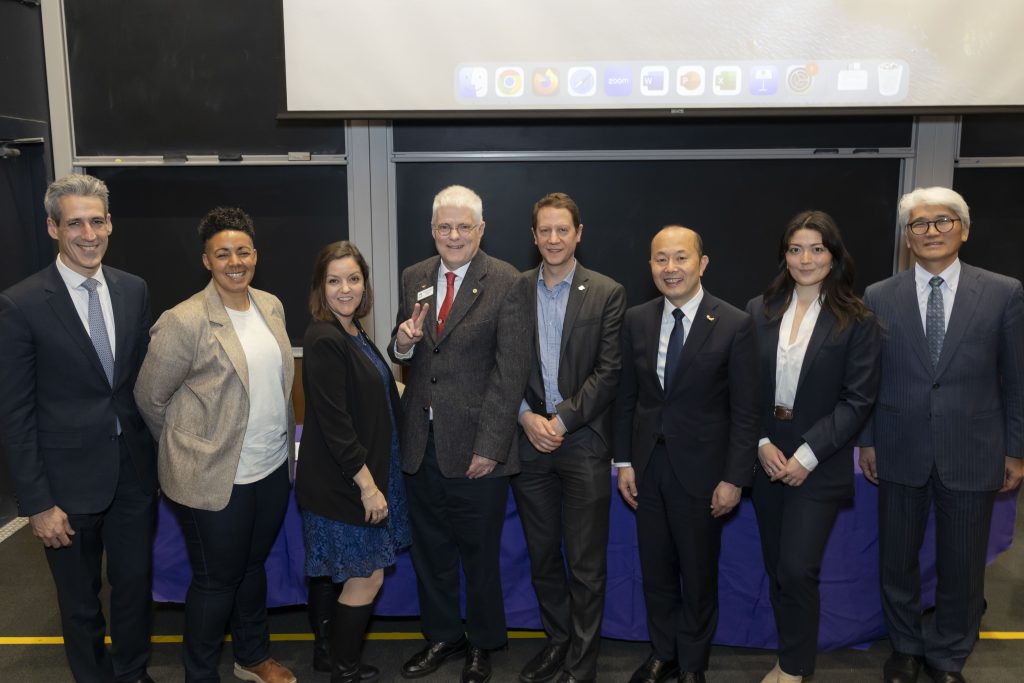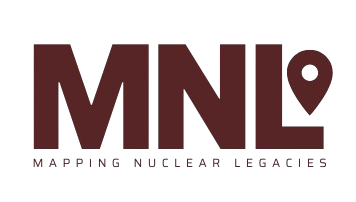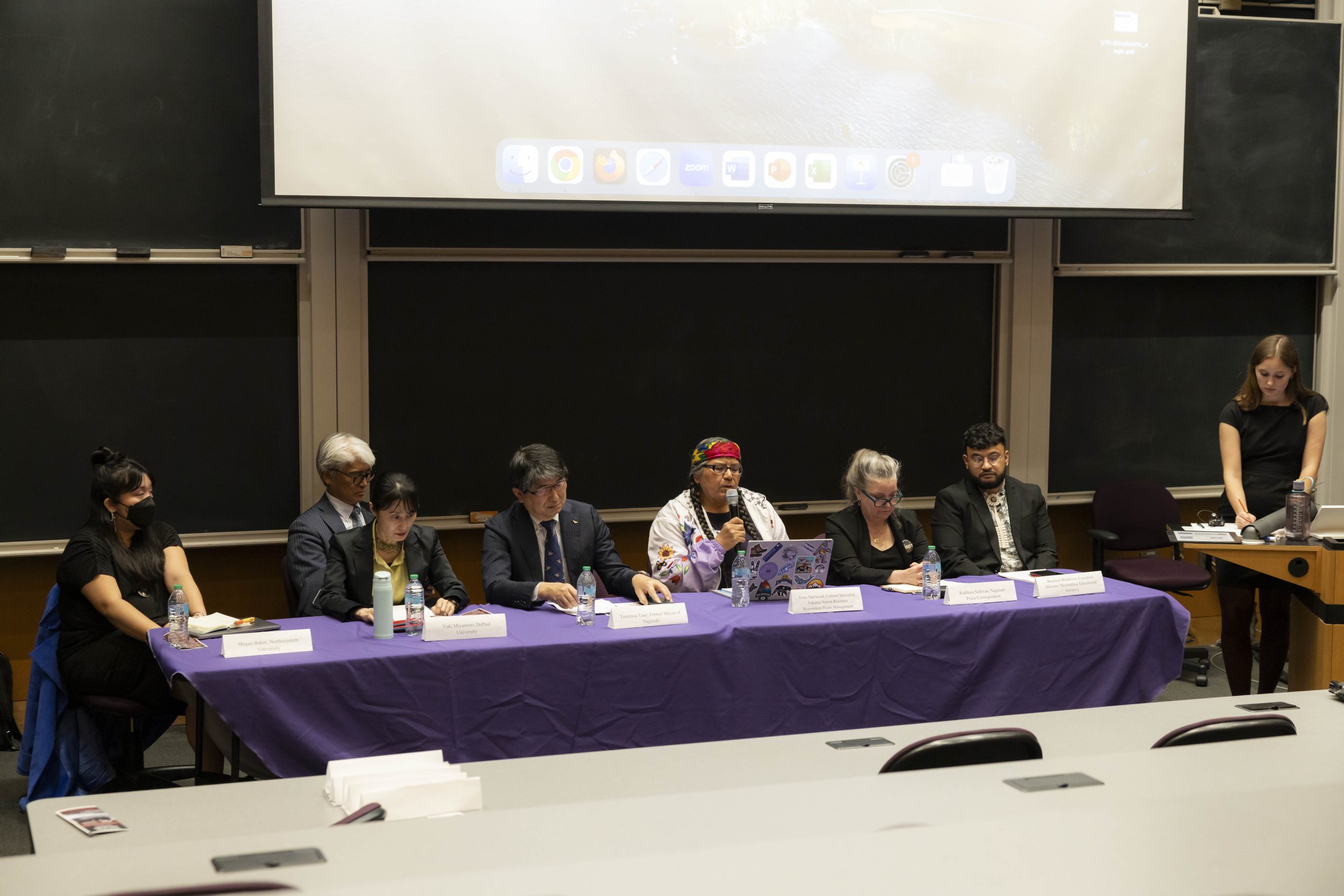On Friday, May 2, 2025, scholars, community leaders, activists, and former elected officials gathered for a critical conversation on intergenerational nuclear justice, part of the Mapping Nuclear Legacies Symposium. This panel centered on the long-lasting environmental, cultural, and health consequences of nuclear weapons development, testing, and deployment, harms that disproportionately impact Indigenous communities, Pacific Islanders, and historically marginalized populations. Panelists included Benetick Kabua Maddison, executive director of the Marshallese Educational Initiative; Trina Sherwood, cultural specialist with the Yakama Nation Resource Restoration and Waste Management Program; Dr. Kathleen Sullivan, director of Hibakusha stories and co-chair of the Nuclear Truth Project; former Nagasaki Mayor Tomihisa Taue; and Dr. Yuki Miyamoto, professor of religious studies and environmental ethics at DePaul University. The panel was moderated by myself, with Dr. Megan Baker, assistant professor of anthropology at Northwestern, serving as the discussant. The conversation explored how memory, activism, and cultural preservation intersect with the ongoing fight for nuclear abolition, offering pathways for younger generations to carry forward this work.
A central theme throughout the discussion was the urgent need to address nuclear harm as a living, evolving injustice, not a historical relic. As frontline survivors like Hibakusha age, the burden of advocacy and remembrance increasingly falls to younger generations. But, as the panelists made clear, this is not just about legacy—It is about confronting the ongoing, compounding effects of nuclear colonialism, health disparities, environmental contamination, and cultural erasure. Intergenerational nuclear justice, as discussed by the panelists, is about both healing and accountability: ensuring survivors’ experiences are honored while actively resisting new and ongoing forms of nuclear harm.

Benetick Kabua Maddison highlighted how nuclear injustice continues to shape the lives of Marshallese people today. Nuclear testing in the Marshall Islands was extensive, with 67 nuclear tests being carried out over twelve years, equivalent to the power of 7,200 atomic bombs like the one dropped on Hiroshima. Maddison stressed that the effects were not limited to the test sites but spread across the entire Marshallese population and their descendants, both on the islands and in the diaspora. Today, over two-thirds of Marshallese people live outside their homeland, often migrating for health care, education, or climate-related reasons, as rising seas threaten their islands and the integrity of structures like the Runit Dome, which contains radioactive waste from U.S. testing. Maddison spoke of the work of the Marshallese Educational Initiative (MEI), which supports Marshallese communities in the U.S. and raises awareness of the intersection between nuclear legacy, health disparities, and climate displacement. He noted that during the COVID-19 pandemic, Marshallese residents in Northwest Arkansas, though just 3% of the local population, accounted for half of the region’s deaths, a devastating statistic he linked to the long-term health impacts of nuclear exposure, including chronic illnesses and forced migration.
Trina Sherwood expanded the conversation to discuss the Yakama Nation’s ongoing fight for land and environmental justice at the Hanford Nuclear Site in Washington State, one of the most contaminated nuclear sites in the world. Sherwood explained how, since the Manhattan Project, Yakama peoples have been forcibly denied access to their ancestral fishing sites, burial grounds, and cultural landscapes along the Columbia River. These lands hold not only environmental significance but profound cultural and spiritual meaning. She described Hanford as both an environmental disaster and a symbol of broken promises and federal neglect, where cleanup efforts are often delayed or mismanaged due to contractor fraud and bureaucratic inertia. Sherwood stressed the importance of mentoring the next generation, including her own daughter, to take up roles in cultural resource management, environmental monitoring, and tribal leadership. Involving Yakama youth in site visits to Hanford and other culturally significant places, she explained, is essential to sustaining cultural practices and resisting the erasure of Indigenous histories. “We can’t live in fear,” Sherwood said. “We have to advocate, continue living our lives as we have since time immemorial, and pass on our culture. That’s how we empower ourselves and become informed.”
Dr. Kathleen Sullivan spoke about the importance of narrative and memory in nuclear abolition efforts, drawing from her decades of work with Hibakusha and her leadership with the Nuclear Truth Project. She shared insights into the challenges of collecting survivor testimonies, noting the emotional and psychological toll it takes on those who relive trauma to educate others. She explained how “the retelling is also the reliving,” and stressed the importance of gathering stories without retraumatizing people.
Sullivan also described how the Treaty on the Prohibition of Nuclear Weapons is the first international security treaty to include provisions for environmental remediation and victim assistance, marking a shift toward recognizing the humanitarian and ecological consequences of nuclear weapons. She stressed the need to challenge the dominant narratives of deterrence and secrecy that continue to shape nuclear discourse. Sullivan emphasized the power of moving from abstract policy conversations to personal connection, recounting her experience working with over 100 Hibakusha and reaching 45,000 students in New York City through arts-based education programs.

Former Mayor of Nagasaki Tomihisa Taue reflected on his 16 years in office and the transition of leadership within the nuclear abolition movement from survivors to younger generations. He spoke about the importance of shared storytelling across generations, noting that younger activists often have different reference points: connecting nuclear weapons to video games or media depictions rather than lived experience. During Nagasaki’s annual Peace Declaration process, he encouraged young people to bring new perspectives, including everyday examples of loss and caregiving, to make the message of peace more accessible. He explained how we need to change how we resolve conflict – not through violence, but through new modes of engagement. The challenge is to avoid the “trap of division” that is so easy to fall into, especially in a primarily online world. Taue warned that the danger of nuclear weapons is compounded by the divisions that prevent global solidarity. He encouraged youth to develop ownership of the disarmament movement, especially as Hibakusha may not be here to share their stories much longer.
Dr. Yuki Miyamoto echoed the need to link nuclear justice to broader systems of oppression. She pointed out that many students are already deeply engaged with issues of environmental justice, racial inequality, and colonialism, but may not immediately connect those struggles to nuclear policy. She described nuclear harm as a form of radioactive colonialism, arguing that naming these injustices explicitly is a critical first step in challenging the dominant narratives that uphold them. Without this naming, people are often left to believe that harm is personal or inevitable, rather than systemic and changeable. Miyamoto leads public education initiatives like the TEAACH Nuclear History Project, bringing nuclear education into Chicago public high school classrooms. She noted that these students quickly grasp the parallels between nuclear injustice and the structural violence they experience in their own communities. But, she cautioned, storytelling alone is not enough; we need to cultivate leadership, not just awareness, to carry the work forward.
Closing out the panel, Dr. Megan Baker reflected on the conversation through an anthropological lens, reminding the audience that nuclear injustice is inseparable from colonialism and structural racism. She emphasized the importance of listening to frontline communities like the Marshallese and Yakama, who live with the consequences of nuclear violence every day. Baker urged the audience to resist the tendency to merely consume stories of trauma; instead, she called for channeling that knowledge into solidarity and meaningful action. Imagining a just future, she argued, requires starting with the voices and experiences of those pushed to the margins, not as an afterthought, but as the essential starting point.
Ultimately, the panel made clear that nuclear justice is not a singular issue but an intergenerational, intersectional struggle that connects environmental health, cultural survival, colonial histories, and the future of peace-building. The conversation called on all attendees, especially youth, to take up this responsibility, not just to remember but to act.

